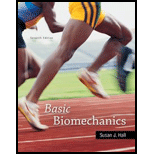
Basic Biomechanics
7th Edition
ISBN: 9780073522760
Author: Susan J Hall
Publisher: McGraw-Hill Education
expand_more
expand_more
format_list_bulleted
Concept explainers
Textbook Question
Chapter 5, Problem 7AP
What specific exercises would you recommend for increasing the flexibility of each of the following joints?
a. Hip
b. Shoulder
c. Ankle
Explain the rationale for your recommendations.
Expert Solution & Answer
Want to see the full answer?
Check out a sample textbook solution
Chapter 5 Solutions
Basic Biomechanics
Ch. 5 - Prob. 1IPCh. 5 - Describe the directions and approximate ranges of...Ch. 5 - Prob. 3IPCh. 5 - Prob. 4IPCh. 5 - What factors contribute to flexibility?Ch. 5 - Prob. 6IPCh. 5 - How is flexibility related to the likelihood of...Ch. 5 - Prob. 8IPCh. 5 - Explain why grip strength diminishes as the wrist...Ch. 5 - Why is ballistic stretching contraindicated?
Ch. 5 - Prob. 1APCh. 5 - How is articular cartilage similar to and...Ch. 5 - Prob. 4APCh. 5 - Discuss the relative importance of joint stability...Ch. 5 - What specific exercises would you recommend for...Ch. 5 - What specific exercises would you recommend for...Ch. 5 - Prob. 8APCh. 5 - Prob. 9APCh. 5 - What exercises would you recommend for senior...
Knowledge Booster
Learn more about
Need a deep-dive on the concept behind this application? Look no further. Learn more about this topic, bioengineering and related others by exploring similar questions and additional content below.Similar questions
- Briefly define the types of joint movements available at a ball-and-socket joint.arrow_forwardThe surgical procedure for loosening of an ankylosed joint is known as _____________. arthrodesis arthrolysisarrow_forwardWhich statement is tine concerning the knee joint? The lateral meniscus is an intrinsic ligament located on the lateral side of the knee joint. Hyperextension is resisted by the posterior cruciate ligament. The anterior cruciate ligament supports the knee when it is flexed and weight bearing. The medial meniscus is attached to the tibial collateral ligament.arrow_forward
- Discuss the structures that contribute to support of the shoulder joint.arrow_forwardThe proximal radioulnar joint ________. is supported by the annular Ligament contains an articular disc that strongly unites the bones is supported by the ulnar collateral ligament is a hinge joint that allows for flexion/extension of the forearmarrow_forwardDescribe the characteristic structures found at all synovial joints.arrow_forward
- The ankle joint ________. is also called the subtalar joint allows for gliding movements that produce inversion/eversion of the foot is a uniaxial hinge joint is supported by the tibial collateral ligament on the lateral sidearrow_forwardThe talus bone of the foot receives the weight of the body from the tibia. The talus bone then distributes this weight toward the ground in two directions: one-half of the body weight is passed in a posterior direction and one-half of the weight is passed in an anterior direction. Describe the arrangement of the tarsal and metatarsal bones that are involved in both the posterior and anterior distribution of body weight.arrow_forwardSupination is the motion that moves the ________. hand from the palm backward position to the palm forward position foot so that the bottom of the foot faces the mid line of the body hand from the palm forward position to the palm backward position scapula in an upward directionarrow_forward
- A high ankle sprain iis an injury caused by over stretching the ligaments connecting the tibia and fibula. What type of joint iis involved in this sprain? ball and socket gomphosis syndesmosis symphysisarrow_forwardWatch this video (http://openstaxcollege.org/l/flexext) to learn more about the flexion and extension of the knee, as the femur both rolls and glides on the tibia to maintain stable contact between the bones in all knee positions. The patella glides along a groove on the anterior side of the distal femur. The collateral ligaments on the sides of the knee become tight in the fully extended position to help stabilize the knee. The posterior cruciate ligament supports the knee when flexed and the anterior cruciate ligament becomes tight when the knee comes into full extension to resist hyperextension. What are the ligaments that support the knee joint?arrow_forwardWhich of the following is a type of synovial joint? a synostosis a suture a plane joint a synchondrosisarrow_forward
arrow_back_ios
SEE MORE QUESTIONS
arrow_forward_ios
Recommended textbooks for you
 Fundamentals of Sectional Anatomy: An Imaging App...BiologyISBN:9781133960867Author:Denise L. LazoPublisher:Cengage Learning
Fundamentals of Sectional Anatomy: An Imaging App...BiologyISBN:9781133960867Author:Denise L. LazoPublisher:Cengage Learning Medical Terminology for Health Professions, Spira...Health & NutritionISBN:9781305634350Author:Ann Ehrlich, Carol L. Schroeder, Laura Ehrlich, Katrina A. SchroederPublisher:Cengage Learning
Medical Terminology for Health Professions, Spira...Health & NutritionISBN:9781305634350Author:Ann Ehrlich, Carol L. Schroeder, Laura Ehrlich, Katrina A. SchroederPublisher:Cengage Learning Anatomy & PhysiologyBiologyISBN:9781938168130Author:Kelly A. Young, James A. Wise, Peter DeSaix, Dean H. Kruse, Brandon Poe, Eddie Johnson, Jody E. Johnson, Oksana Korol, J. Gordon Betts, Mark WomblePublisher:OpenStax College
Anatomy & PhysiologyBiologyISBN:9781938168130Author:Kelly A. Young, James A. Wise, Peter DeSaix, Dean H. Kruse, Brandon Poe, Eddie Johnson, Jody E. Johnson, Oksana Korol, J. Gordon Betts, Mark WomblePublisher:OpenStax College

Fundamentals of Sectional Anatomy: An Imaging App...
Biology
ISBN:9781133960867
Author:Denise L. Lazo
Publisher:Cengage Learning

Medical Terminology for Health Professions, Spira...
Health & Nutrition
ISBN:9781305634350
Author:Ann Ehrlich, Carol L. Schroeder, Laura Ehrlich, Katrina A. Schroeder
Publisher:Cengage Learning



Anatomy & Physiology
Biology
ISBN:9781938168130
Author:Kelly A. Young, James A. Wise, Peter DeSaix, Dean H. Kruse, Brandon Poe, Eddie Johnson, Jody E. Johnson, Oksana Korol, J. Gordon Betts, Mark Womble
Publisher:OpenStax College

GCSE PE - ANTAGONISTIC MUSCLE ACTION - Anatomy and Physiology (Skeletal and Muscular System - 1.5); Author: igpe_complete;https://www.youtube.com/watch?v=6hm_9jQRoO4;License: Standard Youtube License